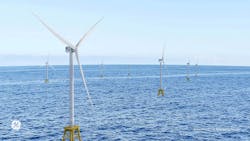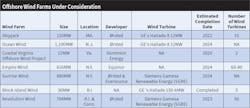Several large wind farms along the East Coast will start producing power on a grand scale over the next few years. To date, much of the action in offshore wind has been in Europe, particularly off the coasts of England, Ireland, Scotland, France, Holland, Germany, Belgium, Denmark, and Sweden.
According to data at www.windeurope.org, “Europe now has a total installed offshore wind capacity of 18,499MW being produced by 4,543 grid-connected wind turbines across 11 countries.” In 2018, 409 new offshore wind turbines were connected to the grid in 18 projects, according to the WindEurope trade group.
The International Brotherhood of Electrical Workers (IBEW) is watching this market closely and was involved with the first offshore wind farm in the United States — the 30MW Block Island Wind Farm, which was commissioned in 2016. E.W. Audet & Sons, Inc., a Providence, R.I.-based electrical contractor, and IBEW Local 99 worked on this project. According to a post on www.ewaudet.com, the company’s crew and Local 99 workers needed specialized training to work offshore on the wind farm, including rescue training, work-at-sea training, and training in climbing. Project manager Jeff Audet said in the post that the crew worked 14-hr days, six to seven days a week. A press release on the IBEW website said another one of its members, Aladdin Electric, Johnston, R.I., worked shore-side on the project, helping to install a temporary construction facility, and that it expects Local 99 workers to be involved with other offshore wind farms in the New England and New York regions.
Environmental concerns slowed development of other offshore wind farms over the past few years, most notably the 800MW Vineyard One proposal off the coast of Martha’s Vineyard, Mass. Nevertheless, several projects were announced or broke ground this year.
Revenue opportunities in this niche may exist for high-voltage electrical contractors that work with the electric utilities and subsidiaries of utilities that install or manage the grid interconnections to these offshore wind farms. There will also be a need for new electrical services at onshore staging areas near ports where the various components of the turbines and foundations are loaded onto specialized ships that transport them to the offshore wind farms.
Bruce Hammett, president and CEO of WECS Renewables, North Palm Springs, Calif., has serviced the wind market for many years. He launched WECS in 1989 as a specialty distributor for the construction, operations, and maintenance segments of the wind market, and over the years the company expanded into solar and energy storage.
Hammett and his team are keeping a close eye on the offshore wind market, and he believes there will eventually be opportunities in the maintenance of the offshore turbines, much as the WECS team services land-based wind farms. He says the turbines and other elements of most offshore wind farms are built to European specifications, but in this country once the power is brought to land, the utility generation products and distribution equipment are built and installed to U.S. specifications.
In an email to Electrical Marketing newsletter, Hammett said offshore wind turbines use many of the same technologies as land-based turbines, but on a much larger scale. “For offshore, we are investigating relationships overseas that might bring to us good partnering for components of all types. The technologies today are, from the electrical, mechanical and hydraulic perspectives, fairly mature and not unfamiliar to the turbines being installed on land,” he wrote.
“The electrical capacity, and therefore the mechanical capacity is so much larger, on the order of potentially three times the size of land-based machines — 8MW to 10MW, with rotors approaching 200-m diameters (approximately 656 ft). And the lifting capacities and methods are considerably different than on land, and the moving of generated electrical power from turbine to shore involve similar efforts to what’s seen on oil rigs and between islands.”
You will see some familiar names in the wind game, including GE Renewable Energy and Siemens [through Siemens Gamesa Renewable Energy (SGRE)]. Both made headlines recently in the wind market because of their high-visibility contracts at new wind farms. Siemens sold 174 of its 7MW offshore turbines to for installation in the Hornsea One wind farm about 75 miles off England’s eastern coast. When complete next year, Hornsea One will be the world’s largest wind farm and provide more than a gigawatt of power to 1 million homes — more than some traditional nuclear power plants.
GE is making news because its massive new Haliade-X 12MW wind turbine, which (at more than 850 ft) is taller than the Statue of Liberty and is said to now be the world’s largest, will be used in the 120MW Skipjack facility off of Maryland’s coast and the 1,100MW Ocean Wind project planned for the coast of New Jersey. According to information on GE’s website, it will be providing Haliade-X wind turbines to Ørsted to build offshore wind farms in New York, Rhode Island, and Connecticut, too. When these wind farms are completed and commissioned by 2024, they will have a combine total capacity of approximately 2.9GW.
Dominion Energy recently began construction of the two-turbine, 12MW Coastal Virginia Offshore Wind Project off the coast of Virginia Beach, Va. According to www.dailypress.com, when completed in 2020, this wind farm will provide 3,000 homes with energy. Other big news this year in the U.S. offshore wind industry were projects off the coasts of New Jersey and New York. Ørsted’s 1,100MW Ocean Wind project off the coast of Atlantic City, N.J., will produce enough electricity to power 500,000 homes. Ørsted has quickly become a big name in the U.S. offshore wind market, and according to a recent company press release, it has a project pipeline with more than 8GW in seven states.
And in July, the state of New York announced its approval of two large farms off the coast of Long Island, N.Y. — Equinor’s Empire Wind and Ørsted & Eversource’s Sunrise Wind development projects. According to a press release from Governor Andrew M. Cuomo’s office, when complete these wind farms will produce 1,700MW — enough to power more than 1 million homes. New York has also pledged $15 million to train workers for offshore wind jobs and develop port infrastructure, according to the same press release.
The American Wind Energy Association (AWEA) estimates the United States has more than 2,000GW in offshore wind potential, and that the offshore leases already negotiated have lots of potential. “There are currently 15 active commercial leases for offshore wind development in the U.S.,” said an AWEA post. “If these leases are fully built, there is the potential to support approximately 25GW of offshore wind capacity.”
Following are some proposed offshore wind farms of note:
• Vineyard Wind 1, Massachusetts: 800MW and 84 turbines
• Vineyard Wind 2, Massachusetts: 400MW to 800MW
• Park City Wind, Connecticut: Up to 1,200MW
• Bay State Wind, Massachusetts: Up to 800 MW, Ørsted and Eversource as developers
• Dominion Energy’s Coastal Virginia Offshore Wind Project, Virginia: Up to 2,000MW
• US Wind: Maryland (250MW) and New Jersey (1,500MW).
Check out the Table below for information on other offshore wind farms under consideration.
About the Author
Jim Lucy
Editor-in-Chief, Electrical Wholesaling & Electrical Marketing
Over the past 40-plus years, hundreds of Jim’s articles have been published in Electrical Wholesaling, Electrical Marketing newsletter and Electrical Construction & Maintenance magazine on topics such as electric vehicles, solar and wind development, energy-efficient lighting and local market economics. In addition to his published work, Jim regularly gives presentations on these topics to C-suite executives, industry groups and investment analysts.
He launched a new subscription-based data product for Electrical Marketing that offers electrical sales potential estimates and related market data for more than 300 metropolitan areas. In 1999, he published his first book, “The Electrical Marketer’s Survival Guide” for electrical industry executives looking for an overview of key market trends.
While managing Electrical Wholesaling’s editorial operations, Jim and the publication’s staff won several Jesse H. Neal awards for editorial excellence, the highest honor in the business press, and numerous national and regional awards from the American Society of Business Press Editors. He has a master’s degree in communications and a bachelor’s degree in journalism from Glassboro State College, Glassboro, N.J. (now Rowan University) and studied electrical design at New York University and graphic design at the School for Visual Arts.



